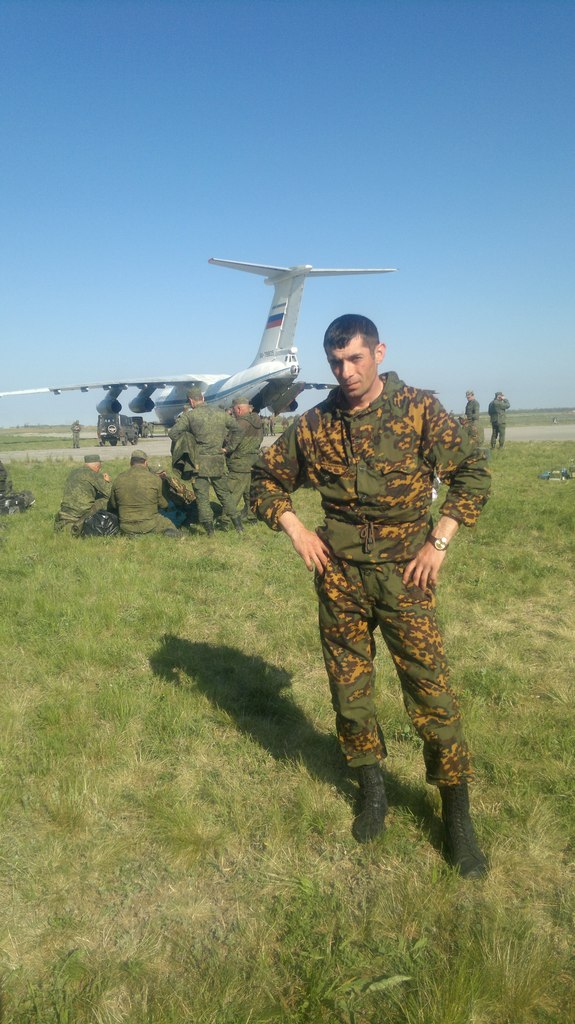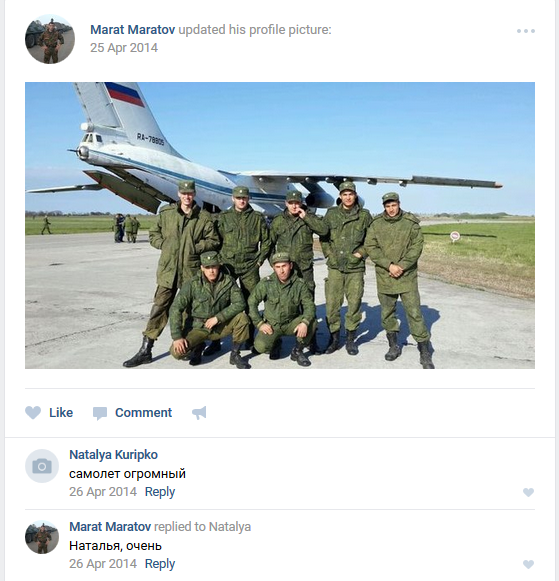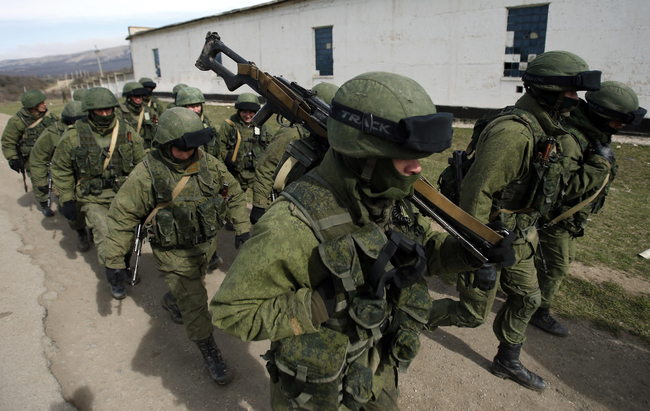The UCA's data contains two text documents with food supply lists dated as 4 and 16 March 2014, which were reportedly discovered in the email box of a Russian supply officer of a military unit based in Chechnya. InformNapalm has conducted an open-source investigation of the soldiers mentioned in the lists and found proof that at least 60 soldiers from the Chechnya-based 18th separate motorized-rifled brigade took part in the occupation of Crimea in 2014.
The Russian occupation of Crimea started back in 2014, four years ago, following the three-month long Euromaidan protests in Ukraine, which culminated in nearly one hundred protesters being shot by police special units, after which then-president Viktor Yanukovych fled Ukraine to Russia. Many top officials, including ministers, parliament members, and heads of state agencies, followed the pro-Russian president, which resulted in a de-facto suspension of many state bodies awaiting the decisions and new appointments from the parliament. Russia took advantage of the short period of political uncertainty in Ukraine to conduct an armed seizure of the Crimean peninsula and to later unleash a war in the East-Ukrainian region of the Donbas. Despite the fact that years have passed, some details of this operation remain uncovered, and the Russian authorities and other participants of the 2014 Crimea invasion haven't been punished yet.
Read the article Annexation of Crimea. How it all happened containing a brief timeline Chronology of the annexation of Crimea
The documents of the hackers
The data obtained by the Ukrainian Cyber Alliance contain two text documents reportedly discovered in the email account of Alexandr Popov, head of food supply rear service of the Rusian military unit no. 2777 of the Southern Military District (the 18th separate motorized-rifled brigade, based in Chechnya). The names of 1097 active Russian servicemen of the unit are mentioned in two food supply lists.
The first document was issued on 6 March 2014. It is an extract from the order #48 of the military unit:
"The military servicemen of the special operations battalion named below are to be considered as departed to conduct a military mission from 7 March 2014, removed from barrack fare, provided with MREs for 11 days from 7 to 17 March, hand the ration certificate directly."
The order body is followed by an appendix listing 202 servicemen.
The second document is also an extract but from another order, #53, of the same military unit dated as 14 March 2014. It obliges to provide 891 servicemen "of the military unit 2777, 63354, 29202" departing for a military mission with food rations for 3 days from 16 to 18 March 2014.
As well, four commanders signed the documents.
The question emerges: what was the military mission of the almost 1,100 soldiers, 202 of whom were spetsnaz troops? Russia claims it didn't wage any wars in March 2014. Nevertheless, both mentioned time intervals perfectly fit into the dates of the Crimea invasion operation.
It is logical to assume that the people on the lists actually participated in the military aggression against Ukraine. But as assumptions are not enough to pin the blame, InformNapalm started searching for more evidence.
The food supply lists
Informnapalm activists have processed the entire list of 1097 soldiers and found open source evidence that at least 101 listed persons took part in military operations outside Russia (9,21% of the list) within the specified period, 60 of whom (5,47%) unambiguously participated in the Crimea invasion. From those 60, 38 servicemen (3,46% of 1097) were decorated with the medal "For the Return of Crimea;" photographs of other 22 Russian soldiers participating in the operation were found on their social profiles as well as other details.
As InformNapalm highlights,
To identify the 60 soldiers from List-1097 and find evidence against them was really hard due to an active Russian campaign during the last several months to prevent Russian serviceman from using social media. We found social media profiles for many soldiers from the list, yet they were already purged [of data - ed]. Nevertheless, the fact that evidence was found not against 1-2 persons but against 60 proves that it can't be a mere coincidence.
The collected evidence may prove the validity of UCA's data on the Russian servicemen of unit 27777 with a high degree of certainty. As well as they prove the participation of the unit in the Crimean operation.

Deployment of the Russian 18th brigade to Crimea in pictures
As photographs in social media show, the 18th motor rifle brigade deployed its servicemen to Crimea by several paths. Most of the images were taken on the civilian car ferrycraft "Nikolai Aksyonenko" in the Russian port "Kavkaz" and Ukrainian port "Krym." One of the images even reveals Russian military equipment loaded on the vehicular ferry. Here are some examples of such images:


Most of the photographs were uploaded after the period from 20 February to 20 March 2014. However, some details prove that they were made amid the operation:
- the servicemen are not clad in a uniform prescribed by military codes;
- many photos show them carrying automatic firearms;
- photographs of the same ferry are found in the social profiles of a group of the soldiers, some pictures show several servicemen at once;
- the military is warmly clad, most of them wear a cold-weather cap, indicating that the photos weren't taken during the summer, which in Crimea lasts from May until October.
Some other facts confirm that the photos were taken within the period of the invasion. For example, Musa Guseev, a warrant officer of the military unit 63354 (mentioned on the second food supply list, located in Dagestan) shared the photograph of the ferry on 11 March 2014:
Two more images reveal the date of the next technical inspection of the ferry lifting tools - 12 September 2014:
The date tells that the pictures couldn't be taken later than 12 September 2014 because the lifting tools would have another date on them. But, as mentioned before, the photographs couldn't be made in summer which lasts in Crimea until mid-fall. That's why the winter-spring of 2014 remains the only theory.
The photos made on land in the port "Krym" provide additional evidence. One of them shows a sign in Ukrainian colors reading, "Ukraine. Crimea," which the occupation authorities swiftly redesigned in the first months of the occupation:

Some of the soldiers from the UCA lists exposed on the ferry in the winter-spring of 2014 were later awarded the medal "For the Return of Crimea," they were Magomed Khamataev, Sergei Karchevsky, Marat Magomedov, and others.
Though Russian soldiers were massively deployed by civilian ferries, other servicemen reached Crimea via alternative methods. For example, InformNapalm activists found photographs in the social profiles of three soldiers made near warships in a port. Moreover, two of them clearly show large landing ships (BDK), one of which was identified as BDK "Kaliningrad" which was listed among the ships used in the deployment of the Russian invasion forces to Crimea in spring 2014:

Marat Magomedov, one of the servicemen who was awarded the Crimean medal, uploaded a photo of himself wearing a non-standard uniform in the foreground of a plane IL-76MD, his other picture shows its tail number RA-78805 identifying it as a Russian military plane:
Unfortunately, the investigators found no solid evidence of the involvement of this plane in the deployment of the Russian troops to Crimea amid the invasion. However, a video points out that it could be used to transport the servicemen of the 18th brigade back from Crimea:
The first half of the video uploaded on 2 October 2014 shows the same plane marked RA-78805 on an unknown airfield approaching a crowd of people mostly clad in winter military uniform. Two persons are talking in Chechen, saying that Putin has sent the plane to bring them home since they have completed their mission. Later they mention that just in case they can capture Donetsk, Kharkiv, and Luhansk. Reportedly, the footage origins from a mobile phone of a Chechen mercenary who fought in Ukraine.
Taking into accounts the above-mentioned photographs, the video gives the ground to assume that it was filmed on one of the airfields captured in Crimea when the invasion operation was complete.
Infantry fighting vehicle BTR-82A from the military unit 27777
One of the profile photos (uploaded on 13 March 2014 ) of Vladimir Lukyantsev, a machine-gunner of the 3rd motorized-rifled detachment of the 3rd platoon of the 3rd company shows a man in a non-standard uniform without insignia near a BTR-82A with a side number 139. The description of the image reads, "In Crimea:"
BTR-82A is an in-depth upgrade of the old Soviet IFV BTR-80 and its shipment to Russian military units started in 2011. The Ukrainian Armed Forces have never bought this model from Russia, thus such equipment couldn't be found anywhere in Ukraine prior to the Russian invasion. The pieces of BTR-82A on other images have the same three-color camouflage pattern which is not widely used in other Russian military units.
The footage captured on 13 March 2014 on the highway Kerch-Feodosiya shows a convoy of 33 pieces of BTR-82A and BMP IFVs (the title of the video states there were more than 40) painted with the same pattern as other IFVs of the unit 27777:
One more similarity is the style of the side number - it's stenciled in maroon both on the video and images. This, together with other matches such as the BTR model and their colors and pattern, makes it likely that these vehicles were in service with the military unit 27777 at the moment of the invasion.
Field camp in the village of Voinka, Crimea
The InformNapalm activists have also discovered photographs of the servicemen in the foreground of tents covered with camouflage nets, old nonresidential one-story buildings, and concrete fences. The area shown on the photos resembled a field camp. Some of the images were published with the geotag Voinka, the same village was mentioned in comments under another image:

Voinka is a strategic location in the north of Crimea where all of the roads meet, which lead to Perekop, one of two necks of land joining the peninsula with mainland Ukraine. The investigators have found footage dated 13 March 2014 showing the Russian military camp allegedly in Voinka:
https://youtu.be/0QkjWCh8N9o
The site was geolocated using old neglected farms south of the village (exact location), images shared by the Russian servicemen from the "List-1097" prove that the location was used by Russian servicemen from Chechnya amid the invasion. One of such examples is a photo from a social profile by Magomedrasul Mugutdinov, a senior driver of a fuel truck of the 2nd detachment of the 1st automobile platoon of the supply battalion:
Dzhankoi district and further details
Other images of the invasion period in the profiles of the servicemen of the Chechnya-based 18th separate motorized-rifled brigade (military unit 27777) show several locations in the North-Crimean Dzhankoi District which may indicate that they could have other not-yet-discovered field camps in Crimea and/or had missions in other locations than Voinka. Here are a few of such photographs:



As InformNapalm stresses, a lot more images shared by the soldiers of the Chechen-based military unit were discovered featuring minor details indicating Russian presence in Ukraine: photos of Ukrainian currency, Ukraine-made juice "Sadochok" on a dining-table, street cafe umbrellas reading "Obolon" (a Ukrainian beer trademark), a Crimea-shaped cake with a Russian flag plugged in atop and so on.
Crimean voyage of the Russian 18th motorized brigade in 2014
Summarizing the finds, the InformNapalm investigators have created a map of the route by the soldiers of the Russian brigade who used the ferry to reach Crimea, the animation shows the way from their permanent base in Chechnya to Crimea and further within the Ukrainian peninsula.
The analysis shows that the deployment of the Russian soldiers in Crimea wasn't a spontaneous decision made in February 2014, as Vladimir Putin states. It was well-organized and prepared and could be fulfilled according to plans prepared well beforehand months or even years before the invasion itself. The coordination of the actions of the military detachments, promptness of their deployment, and the tricks with which they concealed their affiliation with the Russian army show that the act of aggression was prepared long before the invasion and all roles were prescribed by its scenario and rehearsed by the perpetrators. The Kremlin knew that it was violating international law, but Moscow consciously breached the UN articles to commit military crimes, stresses the InformNapalm report.
The full text of the report can be found on the InformNapalm site. Unfortunately, its English version hasn't been published yet, only Ukrainian, Russian, Spanish, Belarusian, Czech, Bulgarian, and Swedish versions are available as of now.
Read more:
- 74 years on, Russian genocide of Crimean Tatars continues
- Hague court rules Russia must compensate Ukrainian investors $159 mn for Crimea losses
- Four years after annexation: Ukraine still connected with occupied Crimea, albeit weakly
- Crimean jailed for Ukrainian flag announces termless hunger strike
- The Crimean Tatar Palace and other historic sites Russia is destroying in occupied Crimea
- Military base instead of a resort: Crimea four years after the occupation
- Crimean factory gets generators from German company in breach of EU sanctions
- Germany, Norway deliver ilmenite ore to occupied Crimea in sanctions breach
- Russian occupiers now hold at least 70 political prisoners in Crimea
- The Russian war against Ukraine by the numbers
- Google Earth imagery reveals major Russian invasion in summer 2014
- Russian occupiers making Ukrainian and Crimean Tatar ‘outcast’ languages
- Crimean Tatar missing since 2014 found dead in occupied Crimea
- Ukraine and the Kremlin's myth of the "polite" invader
- As Crimea was occupied, Western countries cautioned Ukraine against “drastic steps”
- Demobilized Russian conscripts: We “conquered” Crimea, fought in Donbas for Russia
- 21 Ways life in Crimea has changed since the Russian anschluss
- Stages of Russian occupation in a nutshell
- Ex-terrorist leader: "Referendum in Crimea was a farce"















